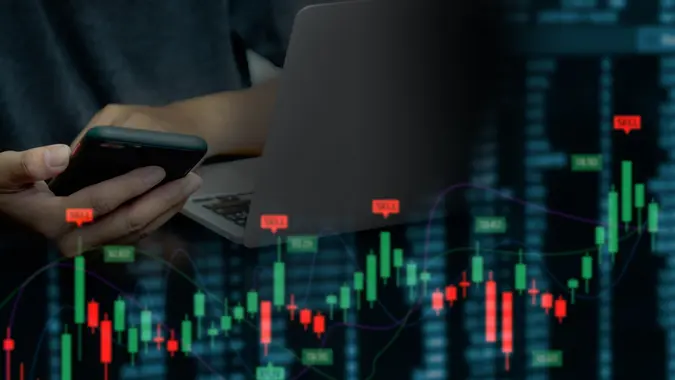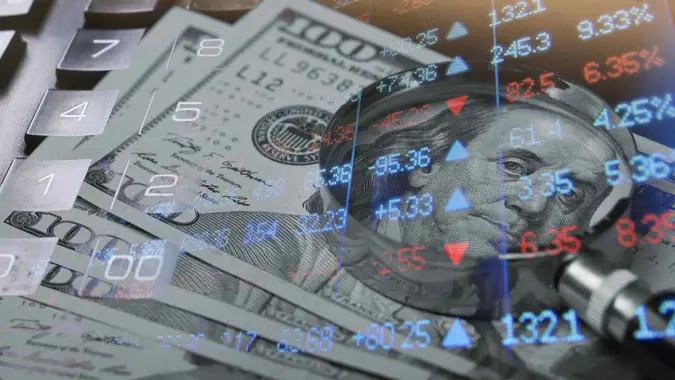Is Palladium a Good Investment? Comparing It to Other Precious Metals

Commitment to Our Readers
GOBankingRates' editorial team is committed to bringing you unbiased reviews and information. We use data-driven methodologies to evaluate financial products and services - our reviews and ratings are not influenced by advertisers. You can read more about our editorial guidelines and our products and services review methodology.

20 Years
Helping You Live Richer

Reviewed
by Experts

Trusted by
Millions of Readers
When people think about investing in precious metals, gold and silver often come to mind first. But there’s another valuable metal worth considering: palladium. If you’re looking to diversify your portfolio, palladium could be a smart addition.
So, is palladium a good investment? Let’s explore its unique benefits, risks and how it stacks up against other metals.
What is Palladium?
Palladium is a rare, silvery-white metal that’s part of the platinum group. It’s prized for its strength, durability and corrosion resistance. While it’s not as well-known as gold or silver, palladium plays a major role in industries like:
- Automotive: It’s a key component in catalytic converters, helping reduce harmful emissions.
- Electronics: Used in connectors and components.
- Jewelry: Valued for its shine and strength.
- Dentistry: Sometimes used in dental fillings and crowns.
Because of its diverse industrial applications and limited supply, palladium has become a sought-after investment metal.
Why Invest in Palladium?
1. High Demand, Limited Supply
Palladium is about 30 times rarer than gold, and its supply is often constrained due to limited mining in countries like Russia and South Africa. This scarcity, combined with high industrial demand, can drive up prices.
2. Economic Resilience
Like gold, palladium can hold its value during economic downturns. When inflation rises or markets falter, precious metals like palladium often become more attractive to investors as a “safe haven.”
3. Portfolio Diversification
Adding palladium to your investment mix can reduce overall risk. Since its value isn’t closely tied to traditional stocks or bonds, it can act as a buffer during market volatility.
Risks of Investing in Palladium
Of course, every investment comes with risks, and palladium is no exception.
1. Price Volatility
Palladium prices can fluctuate due to shifts in supply, industrial demand and global economic conditions. While prices have soared in the past, they can also fall quickly.
2. Supply Chain Concerns
Political instability in major mining regions or shifts in production can impact supply, making prices unpredictable.
3. Market Uncertainty
While demand is currently strong, particularly in the automotive industry, technological advances (like electric vehicles) could reduce the need for palladium in the future.
How to Invest in Palladium
Ready to add palladium to your investment portfolio? Here are the most common ways to invest:
1. Physical Palladium
You can purchase palladium in the form of bullion bars or coins. It’s a tangible investment, which requires storage and insurance considerations. Popular options include:
- Canadian Maple Leaf coins
- American Eagle palladium coins
- Palladium bars from certified dealers
2. Palladium ETFs (Exchange-Traded Funds)
If you prefer a hands-off approach, ETFs allow you to invest in palladium without physically owning it. These funds track the price of palladium and offer an easy way to gain exposure to the metal.
3. Palladium Stocks
You can also invest in companies involved in palladium mining or production. This includes mining giants or companies that rely on palladium for manufacturing. While this approach can offer growth potential, it’s also subject to company performance and broader stock market risks.
4. Palladium Futures
For experienced investors, futures contracts allow you to speculate on the future price of palladium. However, this option is riskier and requires a deeper understanding of the market.
Palladium vs. Other Precious Metals
How does palladium stack up against other precious metals like gold, silver and platinum? Let’s compare:
| Metal | Pros | Cons |
|---|---|---|
| Palladium | High demand, industrial use, limited supply | Volatile prices, supply risks |
| Gold | Long-term store of value, inflation hedge | Price can be slow to rise |
| Silver | Affordable, diverse industrial use | More volatile than gold, price fluctuates |
| Platinum | Valuable industrial metal, similar to palladium | Market demand varies, fewer investment options |
Overall, palladium offers high potential returns but also comes with greater risks due to its price volatility and supply constraints.
Who Should Invest in Palladium?
While palladium isn’t the right choice for everyone, it can be an excellent investment for:
- Growth-Oriented Investors: If you’re seeking higher returns and can handle risk, palladium’s potential price spikes may appeal to you.
- Diversifiers: Adding palladium to an investment portfolio can spread out risk and provide balance.
- Risk-Tolerant Investors: If you’re comfortable with market fluctuations, palladium could be a valuable addition to your strategy.
Final Take to GO
So, is palladium a good investment? The answer depends on your financial goals, risk tolerance, and market outlook. Palladium offers exciting growth opportunities, but it’s also more volatile than traditional investments like gold or silver.
If you’re looking to diversify your portfolio and tap into the industrial demand for this rare metal, palladium could be a valuable addition. Just be sure to research thoroughly and consider how it fits into your broader investment strategy.
Looking to grow your wealth with smart investments? Stay informed, weigh your options and start building a diverse portfolio that aligns with your financial goals.
FAQs About Investing in Palladium
Here are the answers to some of the most frequently asked questions regarding investing in palladium:- Is palladium a good investment for beginners?
- Palladium can be a good option if you're looking to diversify your portfolio and are comfortable with higher risk. However, beginners may want to start with more stable investments like gold or silver before diving into palladium.
- How much should I invest in palladium?
- This depends on your risk tolerance and financial goals. Experts suggest keeping precious metals as 5 to 10% of your overall investment portfolio, with a portion dedicated to palladium if it aligns with your strategy.
- Can I lose all my money in palladium investments?
- While it's unlikely to lose everything, palladium's price can be volatile. Prices may drop due to market changes, so it's important to invest only what you can afford to risk.
Information is accurate as of March 14, 2025.
Editorial Note: This content is not provided by any entity covered in this article. Any opinions, analyses, reviews, ratings or recommendations expressed in this article are those of the author alone and have not been reviewed, approved or otherwise endorsed by any entity named in this article.
Editor's note: This article was produced via automated technology and then fine-tuned and verified for accuracy by a member of GOBankingRates' editorial team.
Our in-house research team and on-site financial experts work together to create content that’s accurate, impartial, and up to date. We fact-check every single statistic, quote and fact using trusted primary resources to make sure the information we provide is correct. You can learn more about GOBankingRates’ processes and standards in our editorial policy.
- USGS "Platinum-Group Metals Statistics and Information"
- Google Finance "Palladium price"
- APMEX "Palladium bullion and coins"
- ETF Database "Palladium ETFs"
- Investing.com "Palladium Futures"
 Written by
Written by  Edited by
Edited by 

























